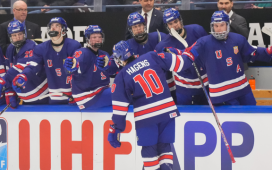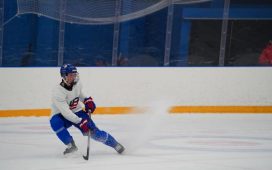A new barnstorming showcase got off to a rousing start in Toronto with a packed arena. Can the superstars of women’s hockey fight their way to a sustainable pro league amidst a chaotic landscape?

Driving to the Toronto stop of the women’s Dream Gap tour, I wasn’t sure what to expect. Westwood Arena is in the city’s northwest, far away from downtown and the subway line. The games took place during the day and at the best of times, Toronto has a crowded field for entertainment. But then I saw a fan walking down the street in a Marie-Philip Poulin jersey before I even got to the rink. And then I tried to find a parking space.
When I got into the arena, it was immediately clear: it was a packed house (approximately 1,200 people), flowing over into ‘standing room only’ territory.
On the ice, I saw Team Poulin beat Team Knox 2-1 in one of four games that would take place at Westwood. Events in San Jose and at Boston College also featured Dream Gap players this past weekend in what was the Professional Women’s Hockey Players Association’s (PWHPA) initial foray into the hockey world.
Women’s hockey has been through the ringer lately, with the CWHL folding under bizarre circumstances and the best players in the world refusing to go back to the NWHL for the 2019-20 campaign. The Dream Gap tour is a way for the best women to keep the sport in the headlines and the Toronto weekend featured Olympic champions such as Poulin, Natalie Spooner and Hilary Knight. Four teams of women played and similar mini-tournaments are scheduled for New Hampshire and Chicago in the coming weeks.
“I thought we put on a good show out there,” Spooner said. “It was a battle and it got a bit chippy. I thought it was exciting for the fans and hopefully they all enjoyed it and want to come back for more. This summer, there were a lot of questions up in the air. Just to get out there – it was so much fun again. It took that pressure off for a second and to see all those little girls in the crowd really made it all worth it.”
For Poulin, the Dream Gap tour wasn’t too much of a leap of faith; it was simply the correct path at this point.
“It was the best option for us,” she said. “We knew it wouldn’t be easy, but we knew it would be worth it. It was scary at first – you play in that league (the CWHL) and then the doors are shut and all of a sudden it’s like, ‘what’s happening?’ Creating this all together we saw hope. The Dream Gap tour is the first step in what we believe in.”
On top of the big crowd, the Dream Gap tour has also been successful in gathering a broad spectrum of support from the business and labor communities. Unifor, the largest private sector union in Canada, is a title sponsor of the tour, while the NHLPA also signed on recently. Big corporate names like Budweiser and Tim Horton’s also jumped aboard.
This type of stuff gets taken for granted at the NHL level (or even the major junior level, for that matter), but it can make a world of difference for pro women who have always been forced to scrape by in the sporting world. One benefit of having Unifor on board was that the union provided hot post-game meals for the players – the same chicken, pasta and salad combos that their male counterparts always have waiting for them.
“We’re trying to create a space for athletes to just be athletes,” said the PWHPA’s Liz Knox, who recently retired as a goalie herself. “I don’t want players running around the rink before games looking for stick tape. In a sustainable league, we want them to show up and just play hockey, to be able to have their body physically prepared, their mind mentally prepared with enough sleep and enough proper nutrition to show up and put their best product on the ice.”
While the initial promises of the NWHL were enticing (actual pay for pro women), sustainability was an issue and many of the pro women playing today still have other jobs to pay their bills. That can cause havoc for gym and practice time.
“Women’s hockey could really take off if we had it as a career and girls were really able to focus solely on hockey,” Spooner said. “And there are a lot of different things, even getting ice time, treatment services, dental plans – things we’ll have to look at down the road.”
What became obvious at the Toronto showcase was that the women involved are looking at the bigger picture, to a future of the game they might not even be a part of.
“Those little girls with sparks in their eyes, that’s why we did it,” Poulin said. “That’s why we’re out there, fighting for what we’re doing right now. We’re all-in together to build the future, to build what we believe in: a viable, sustainable league for the next generation.”
Speaking with insiders, it is evident that the women’s hockey landscape is in a turbulent place right now. Women want one pro league to play in and they want it to be viable in the long-term. Many do not believe the NWHL can be that league and the NHL won’t get involved in anything while the NWHL still exists. But the Dream Gap women have taken matters into their own hands. They’ve been fighting for years and they have nothing to lose by continuing the battle.
“We’re in an extremely pivotal time for the game,” said Hall of Famer and PWHPA consultant Jayna Hefford. “We’re on the verge of history, we’ve never had more momentum and I’ve never been more optimistic for what the future looks like. Of course it’s uncertain, but what these women have done is change the conversation.
“I wanted to see a ton of people out there to validate to these guys that they are supported in what they are trying to achieve and that it’s worth it. This was a difficult time for the players and they were very courageous in what they stepped up to do.”








